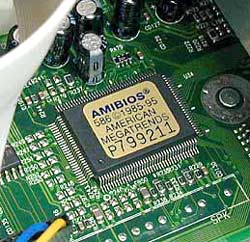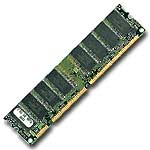RAM and ROM
The previous section talked about the address and data buses, as well as the RD and WR lines. These buses and lines connect either to RAM or ROM -- generally both. In our sample microprocessor, we have an address bus 8 bits wide and a data bus 8 bits wide. That means that the microprocessor can address (2 8 ) 256 bytes of memory, and it can read or write 8 bits of the memory at a time. Let's assume that this simple microprocessor has 128 bytes of ROM starting at address 0 and 128 bytes of RAM starting at address 128.
 ROM chip |
ROM stands for read-only memory. A ROM chip is programmed with a permanent collection of pre-set bytes. The address bus tells the ROM chip which byte to get and place on the data bus. When the RD line changes state, the ROM chip presents the selected byte onto the data bus.
 RAM chip |
By the way, nearly all computers contain some amount of ROM (it is possible to create a simple computer that contains no RAM -- many microcontrollers do this by placing a handful of RAM bytes on the processor chip itself -- but generally impossible to create one that contains no ROM). On a PC , the ROM is called the BIOS (Basic Input/Output System). When the microprocessor starts, it begins executing instructions it finds in the BIOS. The BIOS instructions do things like test the hardware in the machine, and then it goes to the hard disk to fetch the boot sector (see How Hard Disks Work for details). This boot sector is another small program, and the BIOS stores it in RAM after reading it off the disk. The microprocessor then begins executing the boot sector's instructions from RAM. The boot sector program will tell the microprocessor to fetch something else from the hard disk into RAM, which the microprocessor then executes, and so on. This is how the microprocessor loads and executes the entire operating system .
Back to How It Works
› Introduction to How Microprocessors Work
› Microprocessor History
› Inside a Microprocessor
› RAM and ROM
› Microprocessor Instructions
› Microprocessor Performance